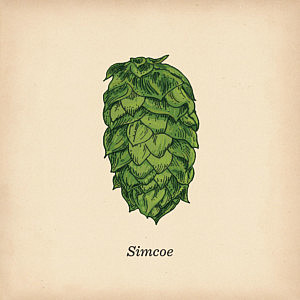August 10, 2018 words: jen beauchesne illustrations: denis routhier
Hoppy just might be the most interesting word in craft beer right now. There has been so much amazing innovation and discovery in the world of hops and hop breeding in the last fifty or so years, which has dramatically expanded the horizon of what hoppy can mean. Bitter? Yes. Piney, citrusy? Yes, and yes. Aromatically tropical, fruity, juicy, earthy, spicy? All yes. Dill, onion? Hop aromas, not just chip flavours! Dank? Oh you better believe your hops can get good and dank.
With all the many hop-a-riffic aromas and flavours that abound, we wanted you to meet and get to know the four different hops that go into Beau’s Full Time I.P.A. The unique hop profile you enjoy in this west-coast-style India Pale Ale is designed around how these hops express themselves, and how they interact with the other ingredients in the beer. Read on to learn a bit about each of the hops in Full Time I.P.A., and then how they come together to create one mega-tasty beer.
Cascade – floral, spicy, grapefruit
Named for an American mountain range, Cascade is a made-in-the-USA hop. It was developed in the late 50s, created by pollinating a UK Fuggle hop seedling with Russian Serebrianker. It was officially put on the market in the 1970s, and in the early part of the craft beer renaissance in North America that followed, it became the signature hop in a popular modern-era I.P.A. Its rise to hop stardom began, and today Cascade has become synonymous with North American beer styles, particularly pale ales and IPAs. Cascade is primarily used as an aroma hop, but can also be used for imparting balancing bitterness. They have a medium intensity, and they contribute fragrantly floral, spicy and citrus/grapefruit elements to a beer like Full Time I.P.A.
Simcoe – pine, fruity, citrus
Talk about having a shady past! Simcoe’s parent-hops identities have been kept a proprietary secret, to keep it from being copied by other hop breeders. It is used mainly in IPAs and North-American style pale ales. It is less than 20 year on the market, having been developed in the USA in the early 2000s. Simcoe is what is known as a dual-purpose hop, favoured for bittering but also useful for adding certain aromas. And its signature characteristics? Well let’s just say, it’s complicated. There can be pine, ripe fruit, and subtle citrus, and it can also contribute notes of berries, and a touch of earth or dankness.
Nelson-Sauvin – tropical, fruity, wine
The hop so nice they named it twice! This hop was developed in New Zealand as part of a hop breeding program, and released to the craft brewing market in 2000. Its parents are New Zealand hops too, the smooth cone variety. It is mainly an aroma hop, but it can also be used to contribute to bittering. It is mainly suited to North-American pale ales and IPAs. Nelson-Sauvin has the fairly unique property of giving off the characteristics of a cool-climate white wine, which is where the Sauvin in its name comes from (sauvignon-blanc). In addition to being described as wine-like, you’ll find beers brewed with this hop to be tropical-fruity, with white grape or gooseberry. Nelson-Sauvin can be a bit of a bully to the other hops, since they are intensely aromatic.
Citra – citrus, tropical fruit
One of the newest hops on the block, citra hops burst onto the hop scene in 2008. They made a big splash in the ten years since, as brewers and craft beer fans alike fell in love with their wonderfully prominent citrusy, tropical fruit aromas. They have a complicated family history as hops go, with hallertau mittelfruh, US Tettnang, Brewers Gold and East Kent Golding all taking some claim to being the parents of this hop-baby. Citra is an aroma hop, and is an especially popular choice for dry-hopping, in which are hops added after the boil for a major aroma-boost. They are most often found accenting North-American style pale ales with their bounds and bounds of citrus and ripe tropical fruit.
Full Time I.P.A.
From Matthew O’Hara, Beau’s Brewmaster: The Synergy, or How It All Comes Together and Works Together People have varying thresholds of sensitivity to the characteristics of the hops at play in Full Time I.P.A. How they all interact and coalesce is fairly ephemeral. The synergy that manifests will be perceived differently by each individual assessor. The key point here is that the complexity is deep and matches the intensity of the beer. The complexity also offers the imbiber a bit of a different experience with each encounter. This is achieved through creating a balance between the four different types of hops used in Full Time I.P.A. The expression on the palate may pivot given the context or setting. The difference may come from the food being paired with the beer; e.g. nachos with mango salsa vs. burgers with sharp cheddar. Likewise, the venue in which the beer is being enjoyed may enhance the experience; a downstairs traditional pub (think of those dank, earthy notes) or a sunny patio by a flower garden (those floral notes).
Share:Original Source Here

